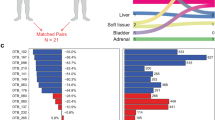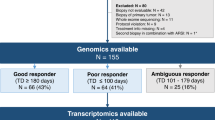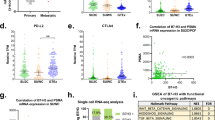Abstract
Background
Men with metastatic prostate cancer who are treated with androgen deprivation therapy (ADT) typically develop therapeutic resistance eventually and have a dismal outcome. Moreover, the limited survival benefit observed in only a proportion of patients receiving novel therapeutics including immune checkpoint blockade and PARP inhibitors suggests the biological heterogeneity of mCRPCs.
Methods
To understand the heterogeneity of mCRPC, we analyzed the transcriptome of 231 mCRPCs and identified four disparate biological subtypes (Basal, Homologous Recombination Repair (HRR), Neuroendocrine and Luminal). The package “randomForest” was used to construct a Random Forest model. Circular plots were used for visualization of TMPRSS2-ERG fusion in each subtype.
Results
The Luminal subtype of mCRPCs has higher Androgen Receptor (AR) expression and copy number alterations as compared with the other subtypes. Genes in HRR pathway are relatively downregulated in most subtypes regardless of the genetic alterations, except for the HRR and NE subtypes, suggesting potential resistance of the HRR and NE mCRPCs to PARP inhibitor treatment. The HRR subtype has relatively more immune cell infiltration and higher expression of immune checkpoints, highlighting that the efficacy of immunotherapy should be evaluated in this particular subtype. TMPRSS2-ERG fusion is the most frequent gene fusion in all mCRPCs, and the Basal subtype has a higher frequency of this fusion than the other subtypes.
Conclusions
Our results reveal that the stratification of mCRPC according to transcriptome is informative of personalized therapeutics in the treatment of mCRPCs. The predictive capacity of the transcriptome subtyping of mCRPC warrants further exploration in the future.
This is a preview of subscription content, access via your institution
Access options
Subscribe to this journal
Receive 4 print issues and online access
$259.00 per year
only $64.75 per issue
Buy this article
- Purchase on Springer Link
- Instant access to full article PDF
Prices may be subject to local taxes which are calculated during checkout





Similar content being viewed by others
Data availability
The data that support the findings of this study are available in GEO, reference number GSE31528, GSE50630, GSE70285. Data was running in this study will be provided upon the reasonable request.
Code availability
The code is available on: https://figshare.com/s/cbe2398424066f8e2a14.
References
Robinson D, Van Allen EM, Wu YM, Schultz N, Lonigro RJ, Mosquera JM, et al. Integrative clinical genomics of advanced prostate. Cancer Cell 2015;162:454.
Rahbar K, Afshar-Oromieh A, Jadvar H, Ahmadzadehfar H. PSMA theranostics: current status and future directions. Mol Imaging 2018;17:1536012118776068.
Haberkorn U, Eder M, Kopka K, Babich JW, Eisenhut M. New strategies in prostate cancer: prostate-specific membrane antigen (PSMA) ligands for diagnosis and therapy. Clin Cancer Res. 2016;22:9–15.
von Eyben FE, Roviello G, Kiljunen T, Uprimny C, Virgolini I, Kairemo K, et al. Third-line treatment and (177)Lu-PSMA radioligand therapy of metastatic castration-resistant prostate cancer: a systematic review. Eur J Nucl Med Mol Imaging 2018;45:496–508.
Mateo J, Porta N, Bianchini D, McGovern U, Elliott T, Jones R, et al. Olaparib in patients with metastatic castration-resistant prostate cancer with DNA repair gene aberrations (TOPARP-B): a multicentre, open-label, randomised, phase 2 trial. Lancet Oncol. 2020;21:162–74.
Armenia J, Wankowicz SAM, Liu D, Gao J, Kundra R, Reznik E, et al. The long tail of oncogenic drivers in prostate cancer. Nat Genet. 2018;50:645–51.
Quigley DA, Dang HX, Zhao SG, Lloyd P, Aggarwal R, Alumkal JJ, et al. Genomic hallmarks and structural variation in metastatic prostate. Cancer Cell 2018;175:889.
Graff JN, Beer TM, Alumkal JJ, Slottke RE, Redmond WL, Thomas GV, et al. A phase II single-arm study of pembrolizumab with enzalutamide in men with metastatic castration-resistant prostate cancer progressing on enzalutamide alone. J Immunother Cancer. 2020;8:e000642.
Abida W, Campbell D, Patnaik A, Shapiro JD, Sautois B, Vogelzang NJ, et al. Non-BRCA DNA damage repair gene alterations and response to the PARP inhibitor rucaparib in metastatic castration-resistant prostate cancer: analysis from the phase II TRITON2 study. Clin Cancer Res. 2020;26:2487–96.
van Dessel LF, van Riet J, Smits M, Zhu Y, Hamberg P, van der Heijden MS, et al. The genomic landscape of metastatic castration-resistant prostate cancers reveals multiple distinct genotypes with potential clinical impact. Nat Commun. 2019;10:5251.
Reig O, Marin-Aguilera M, Carrera G, Jimenez N, Pare L, Garcia-Recio S, et al. TMPRSS2-ERG in blood and docetaxel resistance in metastatic castration-resistant prostate cancer. Eur Urol. 2016;70:709–13.
Marin-Aguilera M, Reig O, Mila-Guasch M, Font A, Domenech M, Rodriguez-Vida A, et al. The influence of treatment sequence in the prognostic value of TMPRSS2-ERG as biomarker of taxane resistance in castration-resistant prostate cancer. Int J Cancer 2019;145:1970–81.
Grande E, Perez MPF, Wetterskog D, Pous AF, Vazquez-Estevez S, Alba AGD, et al. A phase II multicenter biomarker trial to study the predictive value of TMPRSS2-ERG before enzalutamide treatment in chemo-naïve metastatic castration-resistant prostate cancer. J Clin Oncol. 2019;37:5040.
Liu F, Qian J, Ma C. MPscore: a novel predictive and prognostic scoring for progressive meningioma. Cancers (Basel). 2021;13:1113.
Williams JL, Greer PA, Squire JA. Recurrent copy number alterations in prostate cancer: an in silico meta-analysis of publicly available genomic data. Cancer Genet. 2014;207:474–88.
Robinson D, Van Allen EM, Wu YM, Schultz N, Lonigro RJ, Mosquera JM, et al. Integrative clinical genomics of advanced prostate cancer. Cell 2015;161:1215–28.
Zhao SG, Chang SL, Erho N, Yu M, Lehrer J, Alshalalfa M, et al. Associations of luminal and basal subtyping of prostate cancer with prognosis and response to androgen deprivation therapy. JAMA Oncol. 2017;3:1663–72.
Sailer V, Eng KW, Zhang T, Bareja R, Pisapia DJ, Sigaras A, et al. Integrative molecular analysis of patients with advanced and metastatic cancer. JCO Precis Oncol. 2019;3:PO.19.00047.
de Bono J, Mateo J, Fizazi K, Saad F, Shore N, Sandhu S, et al. Olaparib for metastatic castration-resistant prostate cancer. N Engl J Med. 2020;382:2091–102.
Nizialek E, Antonarakis ES. PARP inhibitors in metastatic prostate cancer: evidence to date. Cancer Manag Res. 2020;12:8105–14.
Elia AR, Caputo S, Bellone M. Immune checkpoint-mediated interactions between cancer and immune cells in prostate adenocarcinoma and melanoma. Front Immunol. 2018;9:1786.
Hansen AR, Massard C, Ott PA, Haas NB, Lopez JS, Ejadi S, et al. Pembrolizumab for advanced prostate adenocarcinoma: findings of the KEYNOTE-028 study. Ann Oncol. 2018;29:1807–13.
Antonarakis ES, Piulats JM, Gross-Goupil M, Goh J, Ojamaa K, Hoimes CJ, et al. Pembrolizumab for treatment-refractory metastatic castration-resistant prostate cancer: multicohort, open-label phase II KEYNOTE-199 study. J Clin Oncol. 2020;38:395–405.
Sharma P, Pachynski RK, Narayan V, Flechon A, Gravis G, Galsky MD, et al. Nivolumab plus ipilimumab for metastatic castration-resistant prostate cancer: preliminary analysis of patients in the checkmate 650 trial. Cancer Cell 2020;38:489–99. e3.
Funding
This research was funded by National Natural Science Foundation of China, grant number 81803900.
Author information
Authors and Affiliations
Contributions
YL collected data, analyzed data, and wrote the manuscript; ER analyzed data and edited the manuscript; JQ wrote and edited the manuscript; CM drafted the study, wrote and edited the manuscript; HJ edited the manuscript, and supervised the project. All authors gave final approval of the manuscript.
Corresponding authors
Ethics declarations
Competing interests
The authors declare no competing interests.
Additional information
Publisher’s note Springer Nature remains neutral with regard to jurisdictional claims in published maps and institutional affiliations.
Rights and permissions
About this article
Cite this article
Liang, Y., Rong, E., Qian, J. et al. Transcriptome subtyping of metastatic Castration Resistance Prostate Cancer (mCRPC) for the precision therapeutics: an in silico analysis. Prostate Cancer Prostatic Dis 25, 327–335 (2022). https://doi.org/10.1038/s41391-022-00495-9
Received:
Revised:
Accepted:
Published:
Issue Date:
DOI: https://doi.org/10.1038/s41391-022-00495-9
This article is cited by
-
Identification and validation of cuproptosis related genes and signature markers in bronchopulmonary dysplasia disease using bioinformatics analysis and machine learning
BMC Medical Informatics and Decision Making (2023)



